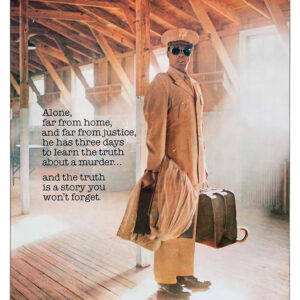calsfoundation@cals.org
A Soldier's Story
A Soldier’s Story is a 1984 dramatic movie filmed entirely in Arkansas at four locations: Clarendon (Monroe County), Fort Chaffee, Fort Smith (Sebastian County), and the Lamar Porter Athletic Field in Little Rock (Pulaski County). After being turned down by several studios, it was produced on an extremely low budget and went on to win numerous awards, earning more than four times what it cost to produce. At a critical point in the filming when there was very little money to pay extras, Governor Bill Clinton helped the production by approving use of Arkansas Army National Guard personnel in full military dress for an essential scene.
The movie starred a number of distinguished actors including Denzel Washington, Howard E. Rollins Jr., Adolph Caesar, Robert Townsend, and David Alan Grier. It was nominated for three Academy Awards including Best Picture, and, among other honors, it won the New York Drama Critics Award and the NAACP Image Award for Outstanding Motion Picture, in addition to being one of 1984’s Ten Best Films of the Year, chosen by the National Board of Review.
The film’s director was Norman Jewison, who was nominated seven times for an Academy Award throughout his career. The movie was based on the Pulitzer Prize–winning off-Broadway production of A Soldier’s Play and concerns African-American soldiers in the South near the end of World War II. The story begins with the murder of an army sergeant and follows the subsequent investigation, which reveals a number of unpleasant truths.
Jewison also agreed to act as the movie’s producer. In a commentary, he says, “No one really wanted to make this movie…a black story, it was based on World War II, and those themes were not popular at the box office.” But Jewison had built a reputation for popular award-winning movies such as Moonstruck, …And Justice for All, Rollerball, Jesus Christ Superstar, Fiddler on the Roof, The Thomas Crown Affair, and In the Heat of the Night. He and many cast members worked for minimum salaries within a $5 million budget from Columbia Pictures after the project was turned down by other studios. According to the Internet Movie Database, the film grossed more than $22 million.
Though the story is set at fictitious locations in Louisiana, it was filmed entirely in Arkansas. It was shot within a very short production schedule, beginning in Clarendon on September 10, 1983. The movie’s opening sequence, billed as “Tynin, Louisiana 1944,” was filmed over three days in Clarendon. Fort Chaffee stood in for Louisiana’s fictitious Fort Neal.
The movie company for A Soldier’s Story was assisted with the help of the Army National Guard’s Fort Chaffee Maneuver Training Center, U.S. Army Ready Reserve. The film’s movie poster features star Howard E. Rollins Jr. in one of the fort’s barracks. Since the film’s budget did not allow for set construction, the barracks in the movie were actual buildings at Fort Chaffee. The intense heat from the lighting equipment often caused shooting to be halted to allow the space to cool down.
Lencola Sullivan, who in 1980 became the first African-American Miss Arkansas, served as production secretary for the project. Among her papers, which she donated to the University of Central Arkansas (UCA) in Conway (Faulkner County), are posters and photos for A Soldier’s Story.
The movie was nominated for Academy Awards including Best Adapted Screenplay, Best Supporting Actor (Adolph Caesar), and Best Picture. Among other accolades, it won three Village Voice Obie Awards as well as the Theater Club Award, the Outer Critics Circle Award, and the New York Drama Critics Award.
For additional information:
Clancy, Sean. “Director’s Movie Had State as Star.” Arkansas Democrat-Gazette, January 28, 2024, p. 1B. Online at https://www.arkansasonline.com/news/2024/jan/28/paper-trials-death-of-noted-director-spurs/ (accessed January 29, 2024).
Halloran, Richard. “Fort Chaffee Journal; From Training Ground to Film Set.” New York Times, February 8, 1988. http://www.nytimes.com/1988/02/08/us/fort-chaffee-journal-from-training-ground-to-film-set.html?_r=0 (accessed October 20, 2020).
Jewison, Norman. This Terrible Business Has Been Good to Me: An Autobiography. New York: Thomas Dunne Books, 2005.
“A Soldier’s Story.” Internet Movie Database. http://www.imdb.com/title/tt0088146/ (accessed October 20, 2020).
Nancy Hendricks
Garland County Historical Society
 Divergent Prosperity and the Arc of Reform, 1968–2022
Divergent Prosperity and the Arc of Reform, 1968–2022 A Soldier's Story Poster
A Soldier's Story Poster 




Comments
No comments on this entry yet.